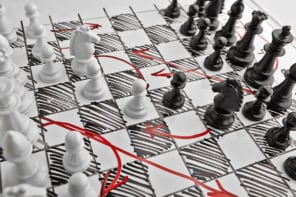By James Dacey
Last Saturday night the Love Parade in Duisburg was supposed to be a celebration of music and revelry, but it turned into one of the most shocking crowd disasters of recent years. 21 people died and hundreds of others were injured as they were crushed trying to escape from a crowd disturbance which escalated into a stampede. Festival planners have come under intense fire for expecting all 1.5 million festival goers to pass through the same tunnel on their entrance to the festival site.
Andreas Schadschneider is a physicist based at Cologne University who specialises in modelling crowds. Since Saturday’s disaster he has been bombarded by inquiries from members of the world’s media who, quite naturally, want to get to the bottom of what happened and whether any of the event’s planning authorities were at fault. I caught up with Schadschneider earlier today to give him a bit more freedom to discuss how the German authorities might respond to this tragedy and how physical modelling might help limit this kind of tragedy in the future.
Early reports have described the panic that broke out just before the entrance to the tunnel, which then triggered a stampede as people tried to escape. As the official inquiries get under way event organizers, the local police and the local planning authorities are all in the firing line. “At the moment, everybody is blaming each other,” he said. Schadschneider feels, however, that we should not jump to any rash conclusions over the specifics of the Duisburg events and who is responsible.
Panic or co-operation?
While Schnadschneider makes it clear that specific details about the Duisburg disaster are not yet available, he does feel that “panic” is an overused term in describing crowd dynamics. This is an issue he explained in a feature article for Physics World in July: “Safety engineers have reviewed hundreds of disasters and found that, in the vast majority of cases, such behaviour has played no – or almost no – role in the tragic events. Instead, the opposite is usually observed, with most people acting co-operatively and altruistically even under extreme conditions”.
Schnadschneider also feels there needs to be better communication systems between stewards and the crowd. “From watching some of the footage, there was a lot of noise including loud music, so it must have been difficult for festival goers to hear police commands”. He believes that one practical way for improving crowd control would be to install more cameras to detect crowd disturbances at an earlier stage. He points out, however, that even if you can detect a disturbance it can be very difficult to alter the flow of people.
Schadschneider hopes that this catastrophe will also force better communication between crowd dynamics researchers and the people responsible for making direct decisions about managing crowds.
More federal planning
Another outcome of this disaster is that festival organization will become more federal, believes Schadschneider. The decisions in relation to crowd management for the Love Parade were taken entirely within the Duisburg administration, but future events of this scale in Germany will probably require additional safety checks by a central governing body.
Schadschneider was keen to point out that while the inquiry may reveal local planning failures, Germany has been among the leading countries for crowd research and its applications. He referred to the success of the 2006 World Cup (which Germany hosted), and World Youth Day of 2005 in which computer modelling helped event organizers to accommodate more than one million people who came to Cologne to witness Pope Benedict XVI speak during his first the first apostolic journey.
Schadschneider’s own research involves studying pedestrian dynamics to develop a computer system that might help in the evacuation of football stadiums. He is developing the Hermes evacuation assistant that could provide data on the distribution of people in a stadium and the availability of rescue routes. It could also predict how people will leave. The video above shows how Schadschneider’s team obtains accurate data by tracking the movement of dynamic streams of people.
Schadschneider emphasises, however, that while these models work well for relatively steady crowd conditions, they are still a long way from predicting all disturbances – indeed they may never be able to do this. “One has to expect the unexpected,” he says.



